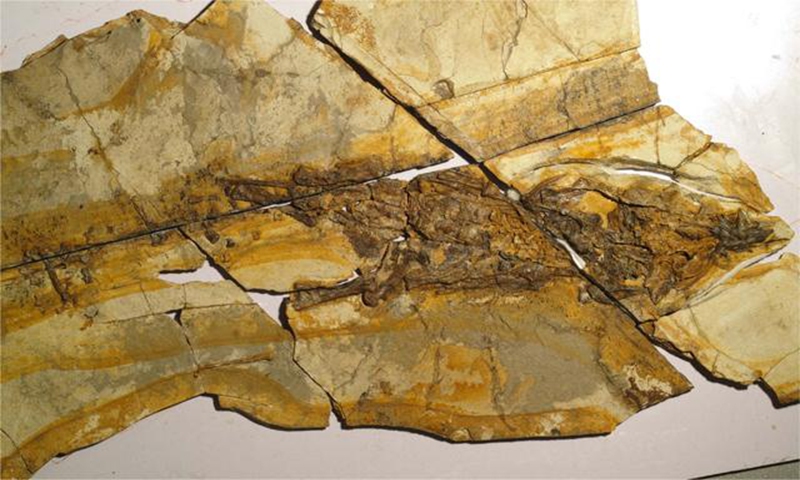
Part of the ceratopsian fossil found in Hebei Province Photo: Courtesy of Department of Natural Resources of Hebei Province
Two fossilized dinosaurs dating back over 130 million years, one with a nearly 100 percent complete skeletal structure and fossilized skin, were unveiled by Chinese paleontologists during a fossil excavation and restoration project in North China's Hebei Province, the Xinhua News Agency reported on Monday.
According to the report, researchers found some dinosaur skeletal remains in Fengning Man Autonomous County within the city of Chengde in 2017. Years of excavation efforts resulted in the unearthing of two exquisitely preserved dinosaur fossils, which can be dated back over 130 million years.
One of the species belongs to a relatively primitive ceratopsian (horned dinosaur) category, with nearly complete skeletal preservation, while the other is a Stegosaurus, boasting a rarely intact set of bones and skin marks.
"The ceratopsian dinosaur fossil discovered this time is a crucial link that will fill the 'gap' in the evolutionary development of ceratopsian dinosaurs. The specimen's almost complete skeletal preservation will provide vital evidence for further research into the evolutionary path of primitive ceratopsian dinosaurs," said Zhang Fucheng, a professor at the Institute of Geology and Paleontology of Linyi University who also leads the research team.
The Stegosaurus dinosaur is about 5 meters long, with skin fossils covering an area of about 3 square meters, scattered around the bone fossils with clear lines arranged like scales.
This discovery marks the first instance of a Stegosaurus dinosaur fossil found in Hebei province, providing compelling evidence that Stegosaurus were active in northern China during the early Cretaceous era.
"While hard parts such as the bones and teeth of dinosaurs are relatively easy to fossilize, the soft tissues such as skin and muscles are easy to rot, and the conditions for forming fossils are extremely harsh," Zhang explained, adding that the preservation level and integrity of the skin fossils are very rare finds worldwide.
Guo Ying, an associate professor at the institute, further noted that this scale-like skin not only protected the Stegosaurus's body but also effectively retained their internal moisture, reducing their dependence on water sources to some extent and enhancing their adaptability to changes in the external environment."
Researchers speculate that the exceptional preservation of the Stegosaurus dinosaur fossil may be attributed to frequent volcanic activities during that period.
"At that time, dinosaurs might have been drinking by the river or lake, or perhaps due to their natural death there, they fell directly into the water, which eventually carried them to deeper areas," suggested Zhang.
According to Zhang, the dinosaur's body was not disturbed by microorganisms or small animals, and the ash fell year after year, leaving the fossils intact.
Researchers believe that 130 million years ago, the Fengning county and its surrounding areas, where these fossils were found, boasted expansive forests and water systems, offering an effective shelter and sufficient food resources for herbivorous dinosaurs to live and thrive in groups.
Having completed the primary restoration of the dinosaur fossils, researchers will proceed with additional restoration work, scientific analysis, and the creation of models and reconstruction illustrations of the dinosaurs, the report said.
URL: https://www.seeglobalnews.com/read-2713.html